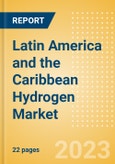The environmental conditions across Latin America and the Caribbean (LAC) create the opportunity for a vast array of renewable resources that can be harnessed for green hydrogen production, including wind, solar, biomass, and hydropower. However, water availability may pose a problem to hydrogen production in the region’s most arid areas. To date, Brazil, Chile, Panama, and Argentina have the most upcoming green hydrogen capacity. Although, other countries are also demonstrating keen interest in the sector. The strong potential for renewable energy means that despite existing hydrocarbon production in several LAC countries, all active and upcoming plants are green hydrogen, not blue. The majority of green hydrogen plants in LAC expect to supply the transportation market, on either a domestic or international basis. This is due to green hydrogen’s potential for decarbonizing long range and heavy transport. LAC will be a net exporter of green hydrogen, having a relatively small demand in comparison to North America, Europe, and Asia. The region is conveniently situated to be able to export to all of these markets. A few countries in the region already have experience in this space, acting as net exporters of grey hydrogen for several years. Early adoption within the region will likely come within refining and industrial sector applications, where hydrogen is already used. Five LAC countries have released national hydrogen plans or strategies. Hydrogen partnerships and M&A deals in LAC have totaled $9.6 billion between January 2019 and May 2023. The LAC companies driving this M&A activity are chiefly situated in the power, oil and gas sectors.
Key Highlights
- Over the last 10 years, the cost of generating electricity from onshore wind and solar has fallen by 35% and 76%, respectively, and is foreseen to continue falling by another 4% and 10% respectively by 2025.
- With a high incidence of solar radiation, Northern Chile’s Atacama Desert has some of the best solar resources in the world. The southern regions of Chile and Argentina and the Caribbean coast of Colombia also have excellent wind resources.
Scope
- Hydrogen country market analysis
- Total upcoming capacity and 2030 market size scenarios, highlighting recently announced projects by capacity.
- Demand across different application sectors.
- National policy support and financial incentives
Reasons to Buy
- Identify the market trends within the country and key players in hydrogen technologies.
- Develop market insight of current, in development and announced capacity and latest trends of the sector.
- Understand LAC country's different scenarios for 2030 based on the likeliness of the projects.
- Look at the demand in key application areas for the country.
- Facilitate the understanding on how and where the market is growing as it is rapidly scaling up to position as one of the main topics of the international and national agenda.
Table of Contents
- Executive Summary
- Snapshot of the low carbon hydrogen market
- Global vs LAC hydrogen production capacity
- Hydrogen production capacity by country and development stage
- Largest upcoming hydrogen projects globally
- Largest upcoming hydrogen projects in LAC
- LAC hydrogen capacity in high and low scenarios
- Low carbon hydrogen competitiveness drivers
- Intended hydrogen use sectors
- Refining
- The low-carbon ammonia opportunity
- Case studies
- National policies
- LAC hydrogen deal activity
- Key players
List of Tables
- Largest low-carbon hydrogen plants in LAC
- Examples of hydrogen developments in LAC across sectors
- National hydrogen strategies
- LAC companies pursuing hydrogen
List of Figures
- Largest low-carbon hydrogen plants in LAC
- Examples of hydrogen developments in LAC across sectors
- National hydrogen strategies
- LAC companies pursuing hydrogen
Companies Mentioned (Partial List)
A selection of companies mentioned in this report includes, but is not limited to:
- GHI Corp
- ACME Group
- BP
- Globeleq
- InterContinental Energy
- Linde plc
- Eren Group SA
- Total Energies SE
- Enegix Energy Pty Ltd
- Humboldt Hidrogeno Verde
- Global Energy Storage Holdings Pte Ltd
- Proton Ventures
- Reggeborgh Group BV
- The Carlyle Group Inc
- Vitol Holding II SA
- Casa dos Ventos Energias Renovaveis SA
- Comerc Eficiencia
- Aker ASA
- Mainstream Renewable Power Ltd
- Fortescue Future Industries Pty Ltd
- CWP Global
- A-Enviro GmbH
- Copenhagen Infrastructure Partners KS
- OKO Wind Erneuerbare Energieerzeugungs GmbH
- Cactus Energia
- Opex Corp
- HIF Global
- Hyndai Motor Co.








